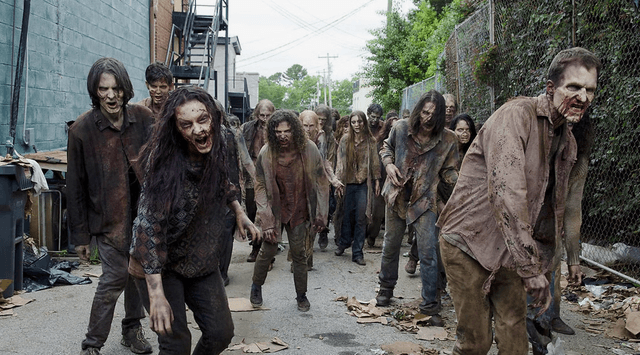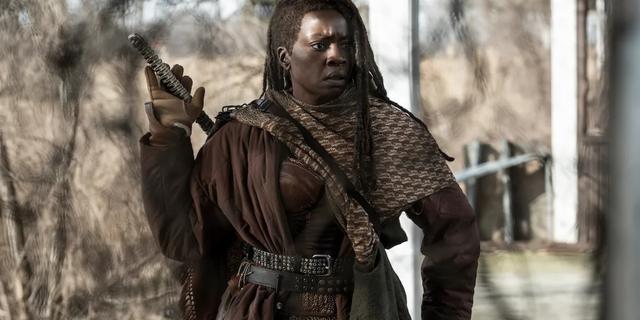If you click on a link and make a purchase we may receive a small commission. Read our editorial policy.
What your Star Wars lightsaber color says about you
Everything you've ever wanted to know about lightsaber colors and symbolism in Star Wars

Why do visitors to the Galaxy’s Edge theme park line up for the privilege of paying $200 to build their lightsaber? Why does every single episode of Star Wars: Visions, each written and directed by a unique team and given the expanse of Star Wars mythology and iconography to play with, feature a lightsaber in some capacity? Why does every single person who has seen a Star Wars movie have their own ironclad opinion on how to make the “vwoo, vwoo” noise when you fire a lightsaber up? The answer to all of these questions in the same: every person who has experienced Star Wars has dreamed about having a lightsaber of their own. Not just to hold that blade of pure light, with the power and legacy it represents, but to personalize it to their very selves. When Obi-Wan Kenobi’s blue saber clashed against Darth Vader’s red in the first film, each color was a representation of their innermost selves, a legend which would take further shape and definition as the saga continued.
Originally, it was a pretty simple code to crack. Blue was good. Red was evil. Green was… easier to show in contrast in daylight against a blue sky in Return of the Jedi, according to Lucasfilm Story Group’s Pablo Hidalgo. But while all that is historically and technically true, it doesn’t feel true. We’re driven to identify with certain colors and give traits to them, to feel as if they represent something we see in ourselves. There’s a reason Samuel L. Jackson specifically requested a purple lightsaber for his character of Mace Windu, after all. Lightsaber colors are personal. And like every tossed off decision in Star Wars, it’s a corner of the galaxy which has developed a mythology of its own.
So when you’re deciding how to tint your laser sword the next time you make an expensive theme park trip, this is what your color of choice might say about you.
BLUE
Notable wielders: Obi-Wan Kenobi, Anakin Skywalker

Blue is the most traditional of lightsaber colors among the Jedi, first appearing as the color of Luke Skywalker and Obi-Wan Kenobi’s lightsabers in A New Hope. According to formerly canonical stories from Lucasfilm through the ‘90s and up until Disney’s restructuring of the Star Wars mythology in 2014, lightsabers once came in every imaginable color from orange to silver. But a thousand years before the events of the films, there was a Sith War which severely limited the supply of crystals available to Jedi to mostly green and blue.
Even going back 5,000 years in the decanonized timeline, referred to now as 'Legends,' blue, green, and yellow were the most commonly found lightsaber colors in the Jedi Order. Once, the Blue Lightsaber was specifically associated with the archetype of the Jedi Guardian; a true knight who values an active role in being a champion of the light through the galaxy. Blue is the color of heroes, who seek out battles against evil, writing wrongs wherever they can be found.
GREEN
Notable wielders: Yoda, Qui-Gon Jinn, Luke Skywalker

As the color of the lightsaber Luke built on his own in Return of the Jedi, the green represents Luke setting a path for himself beyond the knightly blue he inherited from his father. The green also suggests a connection to Luke’s training on the planet Dagobah with Yoda, representing an awareness of the living force and an openness to wisdom which one eluded the petulant young farmboy on a barren world. It’s no coincidence that we eventually learn that Yoda himself had a green lightsaber of his own.
Wielding the green lightsaber, Luke’s greatest victory wasn’t in battle, but in achieving a connection to Darth Vader which opened him back into the light. This suggests then that green is not the color of battle or heroism, but of openness to the Force and the contemplation of its mysteries: the color of those who view their role in the Jedi order as more monastic and contemplative than proactive and heroic. Just as the blue was once associated with Jedi Guardians, the green was once the color of the Jedi Consular, for which the Jedi calling was a scholarly pursuit, and for whom the use of lightsabers was typically a last resort.
YELLOW
Notable wielders: Jedi Temple Guards, Asajj Ventresss, Rey Skywalker

The color yellow, unseen in the original trilogy but widely present in Star Wars stories told outside of the films, was once seen as a representation of balance between the extremes of green and blue. A Jedi Sentinel, who wielded a yellow blade, understood that there was a time to be contemplative and studious of the mysteries of the Force, and a time for action. Sentinels were definitively more pragmatic than other Jedi, valuing practical knowledge and skills as supplementary to knowledge of the Force and skill with a lightsaber. In other words, the perfect color for Rey Skywalker, the scavenger from Jakku who would realize her destiny as The Last Jedi.
Yellow was also the color wielded by Jedi Temple Guards, whose mission was to protect the secrets, traditions, and sacred sites which the Jedi held so dear. While these may seem like opposing viewpoints - one an active participant in the Galaxy, and one cloistered to a solitary purpose - both represent a fusion of feelings and ideologies associated with the green and the blu. But whether that synthesis leads one inward, or outward, is a matter left to the wielder.
RED
Notable wielders: Darth Vader, Darth Sidious, Darth Maul

Red’s the bad guy color. That, at least, hasn’t changed since Darth Vader showed up with it in 1977. There are two interesting histories on how red lightsabers came to be, and both reveal something unique about why that color is associated with the tradition of the Sith. In the previously defined Legends stories, red lightsabers were often the mark that an artificial lightsaber crystal had been used, as the Jedi Order had a tight grip over the control of the true ones – therefore suggesting that a red lightsaber doesn’t necessarily reflect evil, but the color of an outsider; a Force user who must make their own way outside of the regulated system. The color not of necessarily villainy, but of rebellion and bucking of tradition.
The second, more recent explanation, however, and currently the canonical one, is much more terrifying: as part of the trials to become a Sith, one must reach into a lightsaber and corrupt it towards an attunement to the Dark Side – bleeding it until whatever color it once was is replaced with an imposing red. Red, by this current mythology, is the color of corruption, representative of the tragic fall of Darth Vader himself.
PURPLE
Notable wielders: Mace Windu

As the story goes, Samuel L. Jackson specifically requested a purple lightsaber for his character so that he could pick himself out in the crowded Jedi battle in Attack of the Clones. But as stories such as the novel Shatterpoint have delved deeper into Windu’s character than the films were ever concerned, we’re presented with a conflicted soul. Purple is the blend of blue and red, and that is reflected in who Mace Windu is at his heart: a principled proactive Guardian, but one tinged with a darkness he’s constantly fighting back against, rooted on the precipice between both sides of the Force. Mace Windu’s stoic discipline belies a temptation to give into the thrill of battle, and to quickly and decidedly dispatch the enemies of the Jedi so that the Galaxy can know true peace.
The uncomfortable truth is that it’s those connections to the Dark Side, along with the light he must constantly bolster within himself to resist its pull, which make Windu so powerful. Purple, therefore, is the color of the Jedi trying real hard to be the shepherd.
BLACK
Notable wielders: Tarre Viszla, Sabine Wren, The Mandalorian

The Darksaber, while technically Jedi in origin, is one far more important to an entirely different faction of the Galaxy: the tradition of the Mandalorians. Constructed by the ancient Mandalorian Jedi Tarre Viszla, the only true black-bladed lightsaber has become a symbol of strength and leadership among the strictly principled Mandalorian people. Whoever wields it, and came by it truly, has earned the right to dictate the future of the Mandalorians as a whole, and lead them towards future glory – or, should they prove unworthy, ruination. The black lightsaber is for those who know truly in their hearts that 'This is the Way.'
WHITE
Notable wielders: Imperial Knights, Ahsoka Tano

Before the restructure of Star Wars mythology under Disney, there was a period known as the Legacy era where stories over a century after the original film trilogy were told in comics and prose. In this period, the White Lightsaber was wielded by the Imperial Knights, a faction which grew to power long after Palpatine’s demise. These colorless blades represented an allegiance to neither side of the Force, but the morally agnostic ideals of the Empire Reborn. But with the recent Sequel Trilogy of films rewriting the future of Star Wars, that’s an artifact of a period which may no longer exist. As we now understand them, the white lightsaber, as wielded by Ahsoka Tano after her departure from the Jedi Order, represents something much deeper. This brilliant white blade can only be achieved by taking a corrupted, red lightsaber, and purifying it back into the light. In doing so, the saber is not restored to its original color, but ascended to a new form entirely. This arc of the fall to the lowest depths and elevation to the greatest heights, from a typical blue or green, to red, to white, is the most emblematic of the ideals and dramatic arc of Star Wars itself. There’s no story in never turning from the light, and the fall to darkness is incomplete. It’s in that redemption, the experience of the full moral spectrum, where Star Wars thrives, and the Campbellian story circle which informs its narratives achieves completion. A white lightsaber is the color of actualization, having seen the dark and risen above.
With all that in mind, remember that this is simply a guide to the Star Wars archetypes which these colors have come to be associated with. Ultimately, just as we can never be sure that any person perceives color the same way, the feelings we associate with colors are unique to each of us. Choosing a lightsaber color, or any color for anything, is really about what you feel resonates the most with your own preferences. If you’re having trouble making a choice, just take Darth Vader’s advice: search your feelings, and you’ll know it to be true.
Follow Popverse for upcoming event coverage and news
Find out how we conduct our review by reading our review policy
Let Popverse be your tour guide through the wilderness of pop culture
Sign in and let us help you find your new favorite thing.
















Comments
Want to join the discussion? Please activate your account first.
Visit Reedpop ID if you need to resend the confirmation email.